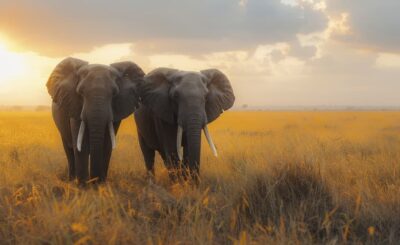Tanzania, renowned for its vast savannahs, diverse ecosystems, and abundant wildlife, faces significant challenges from climate change. As temperatures rise and weather patterns become more erratic, the effects on Tanzania’s natural habitats and wildlife are becoming increasingly apparent. This blog explores the profound impact of climate change on Tanzania’s wildlife and the ongoing conservation efforts aimed at mitigating these challenges.
Climate Change Trends in Tanzania
Climate change in Tanzania manifests through several key trends:
- Temperature Increases: Over the past century, Tanzania has experienced a noticeable rise in temperatures, leading to altered weather patterns and increased frequency of heatwaves. These temperature shifts affect wildlife behavior, plant growth cycles, and water availability in critical habitats.
- Erratic Rainfall Patterns: Climate change has disrupted Tanzania’s traditional rainfall patterns, resulting in more frequent droughts or intense rainfall events. This variability impacts vegetation growth, water sources for wildlife, and the availability of grazing areas for herbivores.
- Glacial Retreat: Mount Kilimanjaro, Africa’s highest peak located in Tanzania, has seen a significant reduction in its ice cap due to global warming. This glacial retreat affects downstream water availability and ecosystems, impacting both wildlife and local communities.
Impact on Wildlife and Ecosystems
The effects of climate change on Tanzania’s wildlife and ecosystems are multifaceted:
- Shifts in Wildlife Distribution: As temperatures rise, wildlife species are forced to adapt by seeking cooler habitats or altering their migration patterns. This can lead to conflicts over resources and increased competition among species.
- Threats to Biodiversity: Endangered species such as the African elephant, rhinoceros, and various antelope species face heightened threats from habitat loss, reduced food availability, and increased vulnerability to diseases exacerbated by climate stress.
- Vulnerability of Marine Life: Coastal ecosystems, including coral reefs and marine species along Tanzania’s coastline and islands, are susceptible to warming ocean temperatures and acidification. These changes threaten marine biodiversity and fisheries that support local livelihoods.
Conservation Efforts and Adaptation Strategies
In response to these challenges, Tanzania has implemented various conservation efforts and adaptation strategies:
- Protected Areas Expansion: The Tanzanian government, in collaboration with conservation organizations, has expanded protected areas and established wildlife corridors to facilitate species movement and adaptation to changing habitats.
- Community-Based Conservation Initiatives: Engaging local communities in conservation efforts is crucial for sustainable wildlife management. Community-based conservancies and eco-tourism initiatives provide economic incentives for communities to protect natural resources and wildlife habitats.
- Climate-Resilient Agriculture: Promoting climate-smart agriculture practices helps mitigate habitat degradation and maintains ecosystem services that support wildlife populations. Sustainable land use practices and reforestation efforts contribute to habitat restoration and carbon sequestration.
- Research and Monitoring: Continuous research and monitoring of wildlife populations, habitat changes, and climate trends provide essential data for adaptive management strategies. This scientific knowledge informs conservation policies and interventions aimed at safeguarding biodiversity.
Global Collaboration and Policy Advocacy
Addressing climate change impacts on Tanzania’s wildlife requires international cooperation and advocacy:
- International Partnerships: Collaborative efforts with global conservation organizations, research institutions, and donor agencies support Tanzania’s conservation goals through funding, technical expertise, and capacity-building initiatives.
- Policy Advocacy: Advocating for climate change mitigation measures and wildlife protection at international forums and policy platforms enhances Tanzania’s resilience to climate impacts. This includes promoting sustainable development practices and reducing carbon emissions globally.
Conclusion
Climate change poses significant challenges to Tanzania’s wildlife and ecosystems, threatening biodiversity and jeopardizing the livelihoods of local communities dependent on natural resources. However, through concerted conservation efforts, adaptive management strategies, and international collaboration, Tanzania is working towards mitigating these impacts and ensuring the long-term survival of its iconic wildlife species.
By promoting sustainable practices, expanding protected areas, and empowering local communities, Tanzania can enhance its resilience to climate change while safeguarding its natural heritage for future generations. Continued research, monitoring, and advocacy efforts are essential in shaping effective policies and actions that protect Tanzania’s wildlife and promote sustainable development in the face of ongoing climate challenges. Together, we can contribute to a future where Tanzania’s diverse ecosystems thrive in harmony with a changing climate.






